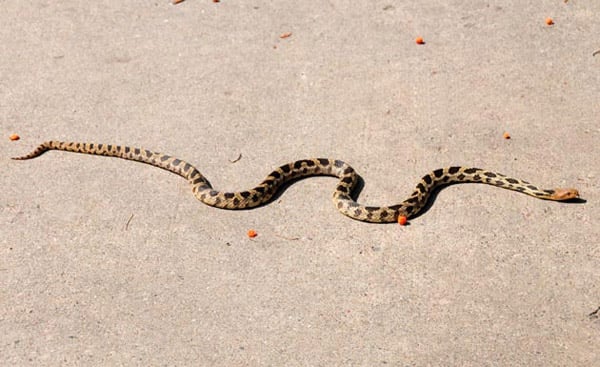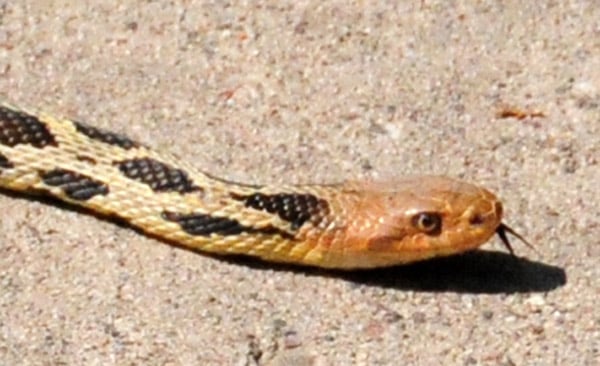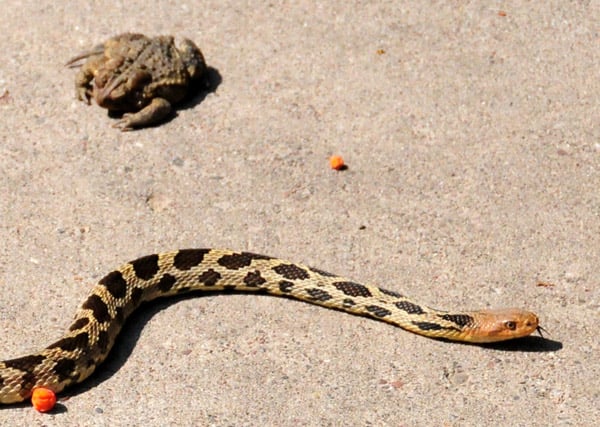LAST UPDATED: May 1st, 2015
The urgency in my wife’s voice yanked me from my basement office without pause or impatient irritation. “There’s a big snake in the driveway, right next to my van,” Penny shouted from the kitchen. She didn’t have to order me outside to deal with it. That was implied. In our home, I’m the hunter and she’s the cook. There’s nothing in her job description about handling wayward snakes, burrowing groundhogs or window-killed birds.
As I headed upstairs, I anticipated handling this like almost every other snake encounter I’ve had in Wisconsin. That is, I’d look and say, “Yep, it’s a snake.” I’d then leave it alone to slither away. Besides, I expected to find a garter snake, Wisconsin’s most common and harmless serpent. But garter snake or not, I can do without such encounters. I’m not a snake person. I seldom look when friends who keep snakes invite me to admire their pets. And when first reading Emily Dickinson’s poem “The Snake” decades ago, her closing lines told me that she and I would get along fine:
“But never met this fellow,
“Attended or alone,
“Without a tighter breathing,
“And zero at the bone.”
A fox snake heads for cover after sunning itself on Patrick Durkin’s driveway in Waupaca, Wisconsin.
The truth is, my blood chills, my heart skips a beat, and I levitate for an instant whenever a snake of any size, stripe or color surprises me. At least Penny eliminated the surprise by spotting it first. In fact, she even stepped on it before noticing it sunning on cement 15 feet from our door. She warned me it might not be what I expected. “It’s big,” she repeated as I grabbed my ball-cap and headed toward the door. Then I spotted it when looking through the door’s window. Sheesh! That’s no garter snake. I stopped, trotted back down to my office, retrieved my camera, and returned to photograph the 3-foot visitor. The neighbor kid was also there, and asked if it was poisonous. No, I assured him. It’s not venomous. Its head is narrow and its eyes round. If its head were wedge-shaped and its eyes elliptical, we’d go to Plan B: Run away, run away!
Fox snakes have a narrow head and round eyes, which distinguish them as a non-venomous species.
So I photographed the snake, which soon grew impatient and slid toward the fieldstone wall flanking our driveway. It was a fox snake, a.k.a., pine snake; Wisconsin’s very own constrictor. That is, like a python, the fox snake wraps itself around prey and squeezes until the victim stops breathing. What’s prey for fox snakes? The list includes mice, birds, frogs, gophers, chipmunks and small rabbits. Fox snakes strike their prey, grab it with their small teeth, and apply their death grip. Once it’s dead, they ingest it head first, their unhinged jaw allowing them to swallow bodies up to five times the diameter of their head. Why is it called a “fox” snake? When disturbed, it emits an odor that stinks like a musky fox. In fact, as I thought about it, I realized I had likely gotten a whiff of this snake a bit earlier when going out to the road to retrieve our newspaper. I had thought I smelled a skunk, but the odor wasn’t as strong.
Unfortunately for fox snakes, hypersensitive folks sometimes kill first and ask questions later when mistaking them for a rattlesnake or copperhead. This, despite the fact copperheads don’t live in Wisconsin and most fox snakes are too big to be a massasauga, one of Wisconsin’s two rattlesnake species. The other is the timber rattler.
When alarmed, fox snakes rapidly shake their tail as if they’re imitating a rattle snake. If they’re in dry leaves, the sound can mimic that of a rattler.
People mistake the fox snake for a copperhead because of its rusty-tan skin with dark spots and blotches. And they can mistake it for a rattler because fox snakes coil, vibrate their tails rapidly in fallen leaves, and strike when feeling threatened. In fact, a friend once opened a cupboard beneath his cabin’s sink and jumped back when a fox snake struck at him and “rattled” its tail against a paper bag. My friend swore it was a rattlesnake until looking more closely at its narrow head. Why it was beneath his sink, we’ll never know. When my friend returned well-armed to remove the snake “permanently” from his cupboard, it was gone. He never saw it again.
Snakes and toads sometimes show up along the edge of the author’s driveway.
More often, people encounter fox snakes in pine barrens, oak savannas, woodlands, near creeks and small rivers, and along field edges bordering woodlots. The Department of Natural Resources says they’re most common near the Yellow, Black and Wisconsin riverways. What became of our fox snake? We haven’t seen it since it slithered into the fieldstones. And if it’s smart, it will stay there and never go near our sink.

 By
By 







